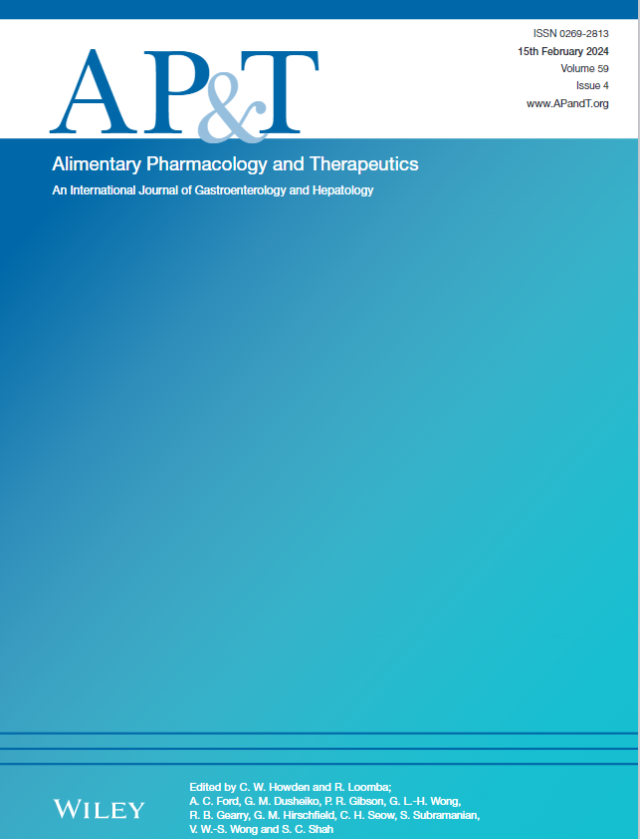Comparative Risk of Hepatitis B Virus Reactivation in Patients Receiving Immune Checkpoint Inhibitors or Tyrosine Kinase Inhibitors for Liver Cancer
IF 6.7
1区 医学
Q1 GASTROENTEROLOGY & HEPATOLOGY
引用次数: 0
Abstract
BackgroundCurrent and past hepatitis B virus (HBV) infection remains the leading cause of liver cancer in endemic areas.AimTo examine the risk of HBV reactivation (HBVr) in patients receiving immune checkpoint inhibitors (ICI) for liver cancer.MethodsPatients with current or past HBV infection receiving systemic treatments for liver cancer from March 2015 to March 2023 were identified using a territory‐wide electronic database in Hong Kong. The primary outcome was HBVr in ICI compared to tyrosine kinase inhibitor (TKI) use, defined according to the American Association for the Study of Liver Diseases criteria. The secondary outcome was HBVr in different types of ICI.ResultsOne thousand five hundred and ninty‐six patients with current or past HBV infection (222 first received ICI; 1374 first received TKI) were included. 205 patients (12.8%) had past HBV infection, and 93.2% of the cohort were on HBV antiviral prophylaxis at baseline. At a median of 10.7 months (IQR: 3.7–12.0), 25 (1.6%) patients had HBVr, among whom 5 were exposed to ICI. The 12‐month cumulative incidence (95% CI) of HBVr of the 1596 patients was 1.7% (1.1%–2.4%). The proportion of patients experiencing HBVr with and without antiviral prophylaxis was 1.4% and 3.7%, respectively. In multivariable analysis, ICI use was not associated with a higher risk of HBVr than TKI use, and the use of different ICI did not impact the risk of HBVr.ConclusionWith adequate antiviral prophylaxis, the absolute risk of HBVr is low in advanced HBV‐related liver cancer patients receiving ICI, regardless of current or past HBV infection.接受免疫检查点抑制剂或酪氨酸激酶抑制剂治疗肝癌患者乙型肝炎病毒再激活的比较风险
背景:目前和过去的乙型肝炎病毒(HBV)感染仍然是流行地区肝癌的主要原因。目的探讨接受免疫检查点抑制剂(ICI)治疗肝癌患者HBV再激活(HBVr)的风险。方法2015年3月至2023年3月期间接受肝癌全身治疗的当前或既往HBV感染患者,使用香港全区域电子数据库进行识别。主要结局是根据美国肝病研究协会的标准,将ICI中的HBVr与酪氨酸激酶抑制剂(TKI)的使用进行比较。次要终点是不同类型ICI的HBVr。结果纳入1596例目前或既往HBV感染患者(222例首次接受ICI; 1374例首次接受TKI)。205例患者(12.8%)既往有HBV感染,93.2%的队列在基线时接受HBV抗病毒预防治疗。在中位10.7个月(IQR: 3.7-12.0)时,25例(1.6%)患者发生HBVr,其中5例暴露于ICI。1596例患者HBVr的12个月累积发病率(95% CI)为1.7%(1.1%-2.4%)。接受和未接受抗病毒预防的HBVr患者比例分别为1.4%和3.7%。在多变量分析中,ICI的使用与HBVr的风险高于TKI的使用无关,并且使用不同的ICI并不影响HBVr的风险。结论:通过充分的抗病毒预防,接受ICI的晚期HBV相关肝癌患者HBVr的绝对风险很低,无论当前或过去是否感染HBV。
本文章由计算机程序翻译,如有差异,请以英文原文为准。
求助全文
约1分钟内获得全文
求助全文
来源期刊
CiteScore
15.60
自引率
7.90%
发文量
527
审稿时长
3-6 weeks
期刊介绍:
Alimentary Pharmacology & Therapeutics is a global pharmacology journal focused on the impact of drugs on the human gastrointestinal and hepato-biliary systems. It covers a diverse range of topics, often with immediate clinical relevance to its readership.

 求助内容:
求助内容: 应助结果提醒方式:
应助结果提醒方式:


